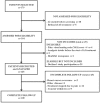Quality of life and impact of pain in women treated with aromatase inhibitors for breast cancer. A multicenter cohort study
- PMID: 29117210
- PMCID: PMC5678681
- DOI: 10.1371/journal.pone.0187165
Quality of life and impact of pain in women treated with aromatase inhibitors for breast cancer. A multicenter cohort study
Abstract
Women with hormone-dependent breast cancer are treated with aromatase inhibitors (AI) to slow disease progression by decreasing estrogen levels. However, AI have adverse effects, including pain, with potentially serious impact on quality of life (QOL) and treatment compliance. We evaluated quality of life during the first year of AI treatment, focusing particularly on the impact of pain. In a multicenter cohort study of 135 women with early-stage breast cancer, free of pain at the initiation of AI treatment, quality of life (by the EORTC QLQ-BR23), somatic and psychic symptoms, psychological characters, temperament and coping strategies were assessed at baseline and at each follow-up visit (1, 3, 6 and 12 months). The impact of treatment-induced pain on quality of life during follow-up was determined with repeated-measures regression models. These models were constructed to assess the effects of pain and pain type on quality of life during follow-up, taking into account predictors associated with quality of life at baseline. Prior ganglion resection, taxane treatment and chemotherapy, a high amplification score on the pain catastrophizing scale, and a high harm avoidance score on the personality questionnaire were associated with a significantly lower baseline QOL. Fifty-seven percent of women developed pain of five different types: upper or lower limb joint pain, diffuse pain, neuropathic pain, tendon pain and mixed pain. A significant decrease in QOL was noted in the women with pain, particularly for body image, sexual functioning and future perspectives. Moreover, the impact of pain on QOL depended on the type of pain experienced. In conclusion, women treated with aromatase inhibitors display changes in quality of life and the degree of change in quality of life depends mostly on the type of pain experienced. Oncologists and patients should be aware of painful adverse effects of AI and encouraged to provide or receive earlier and more appropriate management of these effects.
Conflict of interest statement
Figures


References
-
- Sestak I, Cuzick J, Sapunar F, Eastell R, Forbes JF, Bianco AR, et al. Risk factors for joint symptoms in patients enrolled in the ATAC trial: a retrospective, exploratory analysis. Lancet Oncol. 2008;9: 866–72. doi: 10.1016/S1470-2045(08)70182-7 - DOI - PubMed
-
- Crew K, Greenlee H, Capodice J, Raptis G, Brafman L, Fuentes D, et al. Prevalence of joint symptoms in postmenopausal women taking aromatase inhibitors for early-stage breast cancer. J Clin Oncol. 2007;25: 3877–83. doi: 10.1200/JCO.2007.10.7573 - DOI - PubMed
-
- Fallowfield LJ, Bliss JM, Porter LS, Price MH, Snowdon CF, Jones SE, et al. Quality of life in the intergroup exemestane study: a randomized trial of exemestane versus continued tamoxifen after 2–3 years of tamoxifen in postmenopausal women with primary breast cancer, J Clin Oncol. 2006;24: 910–917. doi: 10.1200/JCO.2005.03.3654 - DOI - PubMed
-
- Yang E, Kim B, Shin H. Use of the international classification of functioning, disability and health as a functional assessment tool for breast cancer survivors. J Breast Cancer. 2012;15: 43–50 doi: 10.4048/jbc.2012.15.1.43 - DOI - PMC - PubMed
-
- Aerts P, De Vries J, Van der Steeg A, Roukema JA. The relationship between morbidity after axillary surgery and long-term quality of life in breast cancer patients: the role of anxiety. Eur J Surg Oncol. 2011;37: 344–9. doi: 10.1016/j.ejso.2011.01.016 - DOI - PubMed
Publication types
MeSH terms
Substances
LinkOut - more resources
Full Text Sources
Other Literature Sources
Medical

